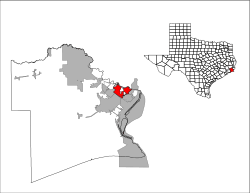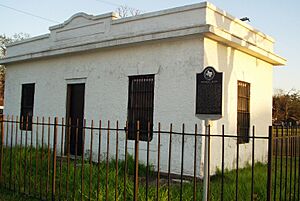Port Neches, Texas facts for kids
Quick facts for kids
Port Neches, Texas
|
|
|---|---|

Location of Port Neches, Texas
|
|
| Country | United States |
| State | Texas |
| County | Jefferson |
| Area | |
| • Total | 9.12 sq mi (23.62 km2) |
| • Land | 8.65 sq mi (22.41 km2) |
| • Water | 0.47 sq mi (1.21 km2) |
| Elevation | 16 ft (5 m) |
| Population
(2020)
|
|
| • Total | 13,692 |
| • Density | 1,462.50/sq mi (564.68/km2) |
| Time zone | UTC-6 (Central (CST)) |
| • Summer (DST) | UTC-5 (CDT) |
| ZIP code |
77651
|
| Area code(s) | 409 |
| FIPS code | 48-58940 |
| GNIS feature ID | 2411465 |
Port Neches is a city in Jefferson County, Texas, United States. It is located near the Neches River. In 2020, about 13,692 people lived there. The city is part of the larger Beaumont–Port Arthur metropolitan area.
History
Long ago, the area where Port Neches now stands was home to Native American tribes. These included the Karankawa and Atakapa people. Two important high spots on the Neches River were Smith's Bluff and Grigsby's Bluff. Grigsby's Bluff is now Port Neches.
The name "Neches" likely comes from the Caddo word "Nachawi." This means "wood of the bow." Spanish settlers later called the river Río Neches.
For at least 1,500 years before 1780, Grigsby's Bluff was a Native American town. First, the Karankawa tribe lived there. Their tall skeletons were often found in burial mounds. After 1650, the Nacazils, a part of the Attakapas tribe, lived there. They were a shorter people. They died out around 1780.
In 1841, there were six large burial mounds at Grigsby's Bluff. These mounds were made of clam and sea shells, skeletons, and pottery. They were about 60 feet wide, 20 feet tall, and 100 yards long. By 1901, all these mounds had disappeared due to human activity. Grigsby's Bluff had a post office in 1859, along with a store and sawmill. The post office closed in 1893.
Port Neches was also the site of Fort Grigsby. This fort was built during the American Civil War in October 1862. Its purpose was to stop the Union Army from moving up the Neches River. The fort was later abandoned, and its weapons were moved to Fort Griffin. This was the site of the Second Battle of Sabine Pass. That battle is known as a big victory for the Confederate side.
The city of Port Neches officially became a city in 1902. The Neches River area is a popular spot for fishing, hunting, bird watching, and boating.
A large chemical processing plant, TPC Group's Port Arthur Refinery, opened in 1944. In November 2019, two explosions happened at this plant. Several people were injured, and homes in Port Neches were damaged. The blasts caused a chemical fire that burned for six days. About 60,000 people from nearby cities had to leave their homes for safety. Air monitors later showed high levels of a chemical called butadiene, leading to a second evacuation.
Geography
Port Neches is located about 20 miles (32 km) away from the Gulf of Mexico.
The city covers a total area of about 9.12 square miles (23.6 square kilometers). Most of this area, about 8.65 square miles (22.4 square kilometers), is land. The rest, about 0.47 square miles (1.2 square kilometers), is water.
Population Information
| Historical population | |||
|---|---|---|---|
| Census | Pop. | %± | |
| 1930 | 2,327 | — | |
| 1940 | 2,487 | 6.9% | |
| 1950 | 5,448 | 119.1% | |
| 1960 | 8,696 | 59.6% | |
| 1970 | 10,894 | 25.3% | |
| 1980 | 13,944 | 28.0% | |
| 1990 | 12,974 | −7.0% | |
| 2000 | 13,601 | 4.8% | |
| 2010 | 13,040 | −4.1% | |
| 2020 | 13,692 | 5.0% | |
| U.S. Decennial Census | |||
This table shows the different groups of people living in Port Neches in 2020:
| Race | Number | Percentage |
|---|---|---|
| White (NH) | 10,483 | 76.56% |
| Black or African American (NH) | 283 | 2.07% |
| Native American or Alaska Native (NH) | 42 | 0.31% |
| Asian (NH) | 462 | 3.37% |
| Some Other Race (NH) | 24 | 0.18% |
| Mixed/Multi-Racial (NH) | 419 | 3.06% |
| Hispanic or Latino | 1,979 | 14.45% |
| Total | 13,692 |
In 2020, there were 13,692 people living in Port Neches. These people lived in 4,707 households, and 3,245 of these were families.
In 2000, the city had 13,601 people. About 25.5% of the population was under 18 years old. The average age was 38 years.
Education
Most of the city is part of the Port Neches–Groves Independent School District. Some parts of the city are served by the Nederland Independent School District.
The Effie & Wilton Hebert Public Library is the local community library. It was named after Wilton Hebert, who helped pay for the current building. The library started in the 1930s with a bookmobile. This was a mobile library that brought books to people.
Later, a one-room library opened between 1932 and 1934. In 1966, the George Boyd Memorial Library opened. The current library building started being built in 1981 and opened in 1982.
Notable people
- Andrew Dismukes, a comedian and writer for Saturday Night Live
- Lee Hazlewood, a country and pop singer and songwriter
- Roschon Johnson, a football player for the University of Texas and Chicago Bears
- L. Q. Jones, an actor and director
- Andrew Landry, a professional golfer
- Tex Ritter, a country music singer and actor
See also
 In Spanish: Port Neches (Texas) para niños
In Spanish: Port Neches (Texas) para niños


